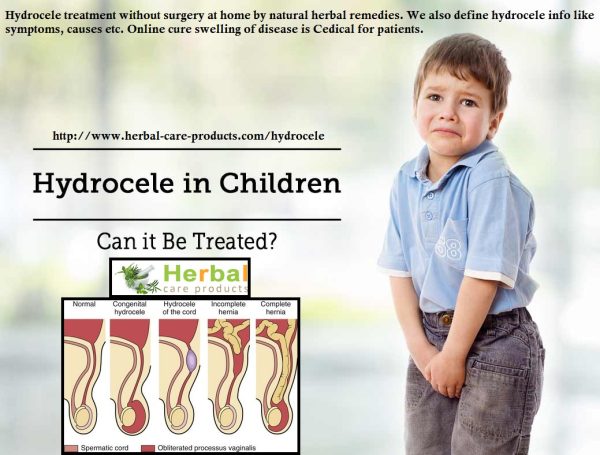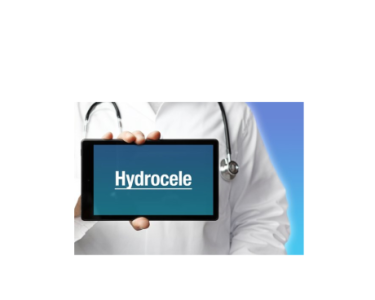Hydrocele Pain by Herbal Care Products
A hydrocele is fluid-filled sac within the scrotum of a male – essentially a backup of fluid around one or both testicles. The condition is relatively common, with an estimated 1-2% of American boys born with one. In most cases, hydroceles are not harmful and tend to go away on their own, without treatment, but scrotal swelling should always be evaluated by a health care provider to rule out other causes. Curing a persistent hydrocele typically requires surgery, although some home remedies may also help. That’s all info posted by Herbal Care Products online company also treat hydrocele pain. In our herbal products have Cedical for patients hydrocele treatment without surgery.
1
Recognize the signs and symptoms. The first indication of a hydrocele is a painless swelling or enlargement of the scrotum, representing a fluid collection around one or both testicles. Babies rarely have complications from a hydrocele and the vast majority disappear before the age of one without treatment. In contrast, men with hydroceles may eventually experience discomfort as the scrotum swells and gets heavy. It can create difficulty sitting or walking / running in extreme cases.
- Pain or discomfort from a hydrocele is generally correlated to its size – the bigger it gets, the more likely you’ll feel it.
- Hydroceles tend to be smaller in the morning (upon waking) and then get more swollen as the day progresses. Straining may cause certain hydrocele’s to increase in size.
- Babies born prematurely have a greater risk of having hydroceles.
2
Be patient with a hydrocele. In the vast majority of cases among baby boys, teenagers and men, hydroceles go away on their own without any specific treatment. The blockage or congestion near the testicle(s) resolves itself and the hydrocele drains and gets absorbed into the body. Thus, if you notice an enlarged scrotum and it’s not painful or causing problems with urination or during sex, give it some time to resolve itself.
- For baby boys, hydroceles usually fade away on their own within one year of being born.
- For men, hydroceles often gradually disappear within six months, depending on the cause. Larger ones may take more time, but shouldn’t go beyond one year without medical intervention.
- However, in children and adolescents hydroceles can be caused by infection, trauma, testicular torsion or tumor, so these conditions must be excluded by examination from a doctor.
- Hydroceles are similar to fluid-filled ganglions that form in tendon sheaths near joints and then gradually disappear.
3
Try an Epsom salt bath. If you notice a painless swelling in your testicle(s)/scrotum, take a very warm bath with at least a few cups of Epsom salt added. Relax in the tub for between 15 – 20 minutes with your legs slightly spread, so that the water engulfs your scrotum. The warmth of the water can stimulate the movement of body fluids (it may help unblock a blockage) and the salt can pull fluid out through your skin and reduce swelling. Epsom salt is also a rich source of magnesium, which helps to relax muscles / tendons and soothe any tenderness.
- If there is pain associated with your hydrocele, then exposing your scrotum to warm water (or any source of heat) may create more inflammation and make your symptoms worse.
- Don’t make the bath too hot (to prevent scalding) and don’t sit in the tub for too long (to prevent dehydration).
4
Avoid trauma to the testes and STDs. The cause of hydroceles is unknown in baby boys, although it’s thought to be a backup of fluid from poor circulation due to the baby’s position in the womb. In older boys and men, however, the cause is usually related to trauma to the scrotum or an infection. Trauma can occur from wrestling, martial arts, cycling and various sexual activities. Infections in the testes/scrotum are often related to sexually transmitted diseases; therefore, protect your scrotum from trauma and practice safe sex.
- If you play contact sports, always wear an athletic supporter with a plastic cup to protect your scrotum from injury.
- Always use a new condom when having sex in order to significantly reduce your risk of infection. STDs don’t always infect the testicles, but it’s not uncommon either
5
Know when to seek medical treatment. You should seek medical attention for your baby boy if his swollen scrotum doesn’t disappear after a year, or it continues to get larger. Men should see their doctor if a hydrocele persists for more than six months, or it gets big enough to cause pain/discomfort or disfigurement.
- A testicular infection is not the same as a hydrocele, but it can cause one secondarily. Testicular infections are very painful and should be treated because they increase your risk of infertility. Always seek medical treatment if you experience scrotal swelling and fever.
- It’s also time to see your doctor if the hydrocele is affecting the way you run, walk or sit.
- Hydroceles don’t impact fertility.
Hydrocele Treatment by Natural Herbal Remedies
1
See your doctor for an examination. If the hydrocele persists for longer than normal or it’s causing pain and other symptoms, then see your family physician for an examination. Hydroceles are not serious, but your doctor will want to rule out other relatively serious conditions that can appear similar, such as: an inguinal hernia, varicocele, infection, benign tumor or testicular cancer. Once a diagnosis of a hydrocele is made, your options are essentially all surgical. Medications are not effective.
- Your doctor may use diagnostic ultrasound, an MRI or a CT scan to better visualize what’s going on inside the scrotum.
- Shining a bright light through the scrotum can tell if the fluid is clear (indicating a hydrocele) or murky, which could be blood and/or pus.
- Blood and urine tests are helpful to rule out infections, such as epididymitis, the mumps or various STDs.
2
Get the fluid removed. Once the hydrocele is diagnosed, the least invasive procedure is to have the fluid drained from the scrotum by a needle, which is called aspiration. After a topical anesthetic is given, a needle is inserted into the scrotum to penetrate the hydrocele, then the clear fluid is removed. If the fluid is bloody and/or pus-filled, then that indicates an injury, infection or perhaps cancer. This procedure is very quick and doesn’t require much recovery time – usually just a day or so.
- Needle drainage of a hydrocele is not done all that often because the fluid usually accumulates again, requiring more treatment.
- Sometimes the needle has to be inserted through the inguinal (groin) area if the hydrocele has formed higher in the scrotum or partially outside of it.
3
Have the entire hydrocele surgically removed. The most common and effective way of dealing with a persistent and/or symptomatic hydrocele is to remove the hydrocele sac along with the fluid – called a hydrocelectomy. This way, there’s only about a 1% chance of the hydrocele developing again. The surgery is either performed with a scalpel or a laparoscope, which has a tiny camera attached to a long cutting device. Hydrocele surgery is typically done at an outpatient clinic under general anesthesia. Recuperation can take up to a week or more, depending if the abdominal wall has to be cut into.
- With babies, surgeons usually cut into the groin (inguinal region) to drain the fluid and remove the sac. Stitches are then used to strengthen the muscle wall – which is essentially the same as a hernia repair surgery.
- In adults, surgeons often cut into the scrotum to drain the fluid and remove the hydrocele sac.
- After a hydrocelectomy, you might need a tube inserted into your scrotum to drain any excess fluid for a few days.
- Depending upon the type of hydrocele, surgical repair may be recommended to decrease the risk of a hernia to the area that is cut off from blood supply.
4
Take it easy while recovering. Recovery from a hydrocele operation is relatively quick in most cases. Otherwise healthy males can typically go home a few hours after surgery — it rarely requires spending overnight in a hospital. Kids should limit their activity (no rough stuff) and get extra bed or couch rest for about 48 hours or so post surgery. Men should follow the same advice, as well as delaying sexual activities for up to a week just to be on the safe side.
- In most patients following a hydrocele operation, normal activity can restart after four to seven days.
- Potential complications from surgery to look out for include: allergic reaction to anesthesia (breathing problems), bleeding within or outside the scrotum that won’t stop, and potential infection.
- Signs of bacterial infection include groin pain, inflammation, redness, a foul odor and possibly a mild fever.
This all about hydrocele disease by the Herbal Care products. I hope you get the hydrocele treatment from this herbal care products blog. Because treatment of hydrocele is the Cedical herbal products for patients. treatment for hydrocele every one online order Cedical.
Source Link : https://www.wikihow.com/Cure-a-Hydrocele




